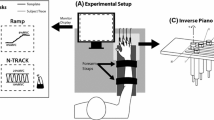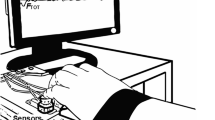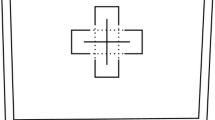Abstract
We investigated the ability of two persons to produce force-stabilizing synergies in accurate multi-finger force production tasks under visual feedback on the total force only. The subjects produced a time profile of total force (the sum of two hand forces in one-person tasks and the sum of two subject forces in two-person tasks) consisting of a ramp-up, steady-state, and ramp-down segments; the steady-state segment was interrupted in the middle by a quick force pulse. Analyses of the structure of inter-trial finger force variance, motor equivalence, anticipatory synergy adjustments (ASAs), and the unintentional drift of the sharing pattern were performed. The two-person performance was characterized by a dramatically higher amount of inter-trial variance that did not affect total force, higher finger force deviations that did not affect total force (motor equivalent deviations), shorter ASAs, and larger drift of the sharing pattern. The rate of sharing pattern drift correlated with the initial disparity between the forces produced by the two persons (or two hands). The drift accelerated following the quick force pulse. Our observations show that sensory information on the task-specific performance variable is sufficient for the organization of performance-stabilizing synergies. They suggest, however, that two actors are less likely to follow a single optimization criterion as compared to a single performer. The presence of ASAs in the two-person condition might reflect fidgeting by one or both of the subjects. We discuss the characteristics of the drift in the sharing pattern as reflections of different characteristic times of motion within the subspaces that affect and do not affect salient performance variables.





Similar content being viewed by others
References
Ambike S, Zatsiorsky VM, Latash ML (2015) Processes underlying unintentional finger force changes in the absence of visual feedback. Exp Brain Res 233:711–721
Arpinar-Avsar P, Park J, Zatsiorsky VM, Latash ML (2013) Effects of muscle vibration on finger interaction and coordination. Exp Brain Res 229:103–111
Bernstein NA (1967) The co-ordination and regulation of movements. Pergamon Press, Oxford
Black DP, Riley MA, McCord CK (2007) Synergies in intra- and interpersonal interlimb rhythmic coordination. Mot Control 11:348–373
Bobath B (1978) Adult hemiplegia: evaluation and treatment. William Heinemann, London
Bosga J, Meulenbroek RG (2007) Joint-action coordination of redundant force contributions in a virtual lifting task. Mot Control 11:235–258
d’Avella A, Saltiel P, Bizzi E (2003) Combinations of muscle synergies in the construction of a natural motor behavior. Nat Neurosci 6:300–308
DeWald JP, Pope PS, Given JD, Buchanan TS, Rymer WZ (1995) Abnormal muscle coactivation patterns during isometric torque generation at the elbow and shoulder in hemiparetic subjects. Brain 118:495–510
Fine JM, Amazeen EL (2011) Interpersonal Fitts’ law: when two perform as one. Exp Brain Res 211:459–469
Fine JM, Gibbons CT, Amazeen EL (2013) Congruency effects in interpersonal coordination. J Exp Psychol Hum Percept Perform 39:1541–1556
Flanagan JR, Bowman MC, Johansson RS (2006) Control strategies in object manipulation tasks. Curr Opin Neurobiol 16:650–659
Gelfand IM, Tsetlin ML (1966) On mathematical modeling of the mechanisms of the central nervous system. In: Gelfand IM, Gurfinkel VS, Fomin SV, Tsetlin ML (eds) Models of the structural-functional organization of certain biological systems, pp 9–26, Nauka: Moscow (1966) (in Russian, a translation available in 1971 edition by MIT Press, Cambridge)
Goodman SR, Latash ML (2006) Feedforward control of a redundant motor system. Biol Cybern 95:271–280
Ivanenko YP, Poppele RE, Lacquaniti F (2004) Five basic muscle activation patterns account for muscle activity during human locomotion. J Physiol 556:267–282
Klous M, Mikulic P, Latash ML (2011) Two aspects of feed-forward postural control: anticipatory postural adjustments and anticipatory synergy adjustments. J Neurophysiol 105:2275–2288
Knoblich G, Jordan JS (2003) Action coordination in groups and individuals: learning anticipatory control. J Exp Psychol Learn Mem Cogn 29:1006–1016
Krishnan V, Aruin AS, Latash ML (2011) Two stages and three components of postural preparation to action. Exp Brain Res 212:47–63
Kugler PN, Turvey MT (1987) Information, natural law, and the self-assembly of rhythmic movement. Erlbaum, Hillsdale
Kugler PN, Kelso JAS, Turvey MT (1980) On the concept of coordinative structures as dissipative structures. I. Theoretical lines of convergence. In: Stelmach GE, Requin J (eds) Tutorials in motor behavior. N-Holland Publ.Co, Amsterdam, pp 3–45
Latash ML (2008) Synergy. Oxford University Press, New York
Latash ML (2012) The bliss (not the problem) of motor abundance (not redundancy). Exp Brain Res 217:1–5
Latash ML, Scholz JF, Danion F, Schöner G (2001) Structure of motor variability in marginally redundant multi-finger force production tasks. Exp Brain Res 141:153–165
Latash ML, Scholz JP, Schöner G (2002) Motor control strategies revealed in the structure of motor variability. Exer Sport Sci Rev 30:26–31
Latash ML, Shim JK, Smilga AV, Zatsiorsky V (2005) A central back-coupling hypothesis on the organization of motor synergies: a physical metaphor and a neural model. Biol Cybern 92:186–191
Latash ML, Scholz JP, Schöner G (2007) Toward a new theory of motor synergies. Mot Control 11:276–308
Li ZM, Latash ML, Zatsiorsky VM (1998) Force sharing among fingers as a model of the redundancy problem. Exp Brain Res 119:276–286
Martin V, Scholz JP, Schöner G (2009) Redundancy, self-motion and motor control. Neural Comput 21:1371–1414
Massion J (1992) Movement, posture and equilibrium—interaction and coordination. Prog Neurobiol 38:35–56
Masumoto J, Inui N (2013) Two heads are better than one: both complementary and synchronous strategies facilitate joint action. J Neurophysiol 109:1307–1314
Mattos D, Latash ML, Park E, Kuhl J, Scholz JP (2011) Unpredictable elbow joint perturbation during reaching results in multijoint motor equivalence. J Neurophysiol 106:1424–1436
Mattos D, Kuhl J, Scholz JP, Latash ML (2013) Motor equivalence (ME) during reaching: is ME observable at the muscle level? Mot Control 17:145–175
Mattos D, Schöner G, Zatsiorsky VM, Latash ML (2015) Motor equivalence during accurate multi-finger force production. Exp Brain Res 233:487–502
Olafsdottir H, Yoshida N, Zatsiorsky VM, Latash ML (2005) Anticipatory covariation of finger forces during self-paced and reaction time force production. Neurosci Lett 381:92–96
Park J, Zatsiorsky VM, Latash ML (2010) Optimality vs. variability: an example of multi-finger redundant tasks. Exp Brain Res 207:119–132
Prilutsky BI, Zatsiorsky VM (2002) Optimization-based models of muscle coordination. Exerc Sport Sci Rev 30:32–38
Reschechtko S, Zatsiorsky VM, Latash ML (2014) Stability of multifinger action in different state spaces. J Neurophysiol 112:3209–3218
Riley MA, Richardson MJ, Shockley K, Ramenzoni VC (2011) Interpersonal synergies. Front Psychol. doi:10.3389/fpsyg.2011.00038
Rizzolatti G, Fogassi L (2014) The mirror mechanism: recent findings and perspectives. Philos Trans R Soc Lond B Biol Sci 369(1644):20130420
Schmidt RC, Carello C, Turvey MT (1990) Phase transitions and critical fluctuations in the visual coordination of rhythmic movements between people. J Exp Psychol Hum Percept Perform 16:227–247
Scholz JP, Schöner G (1999) The uncontrolled manifold concept: identifying control variables for a functional task. Exp Brain Res 126:289–306
Scholz JP, Danion F, Latash ML, Schöner G (2002) Understanding finger coordination through analysis of the structure of force variability. Biol Cybern 86:29–39
Schöner G (1995) Recent developments and problems in human movement science and their conceptual implications. Ecol Psychol 8:291–314
Shapkova EYu, Shapkova AL, Goodman SR, Zatsiorsky VM, Latash ML (2008) Do synergies decrease force variability? A study of single-finger and multi-finger force production. Exp Brain Res 188:411–425
Shim JK, Olafsdottir H, Zatsiorsky VM, Latash ML (2005) The emergence and disappearance of multi-digit synergies during force production tasks. Exp Brain Res 164:260–270
Shim JK, Park J, Zatsiorsky VM, Latash ML (2006) Adjustments of prehension synergies in response to self-triggered and experimenter-triggered load and torque perturbations. Exp Brain Res 175:641–653
Shockley K, Santana MV, Fowler CA (2003) Mutual interpersonal postural constraints are involved in cooperative conversation. J Exp Psychol Hum Percept Perform 29:326–332
Stoffregen TA, Giveans MR, Villard S, Yank JR, Shockley K (2009) Interpersonal postural coordination on rigid and non-rigid surfaces. Mot Control 13:471–483
Terekhov AV, Pesin YB, Niu X, Latash ML, Zatsiorsky VM (2010) An analytical approach to the problem of inverse optimization: an application to human prehension. J Math Biol 61:423–453
Ting LH, Macpherson JM (2005) A limited set of muscle synergies for force control during a postural task. J Neurophysiol 93:609–613
Todorov E, Jordan MI (2002) Optimal feedback control as a theory of motor coordination. Nat Neurosci 5:1226–1235
Vaillancourt DE, Russell DM (2002) Temporal capacity of short-term visuomotor memory in continuous force production. Exp Brain Res 145:275–285
Vaillancourt DE, Slifkin AB, Newell KM (2001) Visual control of isometric force in Parkinson’s disease. Neurophysiologia 39:1410–1418
van der Wel RP, Knoblich G, Sebanz N (2011) Let the force be with us: dyads exploit haptic coupling for coordination. J Exp Psychol Hum Percept Perform 37:1420–1431
Wilhelm L, Zatsiorsky VM, Latash ML (2013) Equifinality and its violations in a redundant system: multi-finger accurate force production. J Neurophysiol 110:1965–1973
Zhou T, Solnik S, Wu Y-H, Latash ML (2014) Unintentional movements produced by back-coupling between the actual and referent body configurations: violations of equifinality in multi-joint positional tasks. Exp Brain Res 232:3847–3859
Acknowledgments
This work was supported in part by NIH Grants NS-035032 and AR-048563.
Author information
Authors and Affiliations
Corresponding author
Rights and permissions
About this article
Cite this article
Solnik, S., Reschechtko, S., Wu, YH. et al. Force-stabilizing synergies in motor tasks involving two actors. Exp Brain Res 233, 2935–2949 (2015). https://doi.org/10.1007/s00221-015-4364-z
Received:
Accepted:
Published:
Issue Date:
DOI: https://doi.org/10.1007/s00221-015-4364-z




